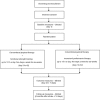FAST INdiCATE Trial protocol. Clinical efficacy of functional strength training for upper limb motor recovery early after stroke: neural correlates and prognostic indicators
- PMID: 24025033
- PMCID: PMC4228758
- DOI: 10.1111/ijs.12179
FAST INdiCATE Trial protocol. Clinical efficacy of functional strength training for upper limb motor recovery early after stroke: neural correlates and prognostic indicators
Abstract
Rationale: Functional strength training in addition to conventional physical therapy could enhance upper limb recovery early after stroke more than movement performance therapy plus conventional physical therapy.
Aims: To determine (a) the relative clinical efficacy of conventional physical therapy combined with functional strength training and conventional physical therapy combined with movement performance therapy for upper limb recovery; (b) the neural correlates of response to conventional physical therapy combined with functional strength training and conventional physical therapy combined with movement performance therapy; (c) whether any one or combination of baseline measures predict motor improvement in response to conventional physical therapy combined with functional strength training or conventional physical therapy combined with movement performance therapy.
Design: Randomized, controlled, observer-blind trial.
Study: The sample will consist of 288 participants with upper limb paresis resulting from a stroke that occurred within the previous 60 days. All will be allocated to conventional physical therapy combined with functional strength training or conventional physical therapy combined with movement performance therapy. Functional strength training and movement performance therapy will be undertaken for up to 1·5 h/day, five-days/week for six-weeks.
Outcomes and analysis: Measurements will be undertaken before randomization, six-weeks thereafter, and six-months after stroke. Primary efficacy outcome will be the Action Research Arm Test. Explanatory measurements will include voxel-wise estimates of brain activity during hand movement, brain white matter integrity (fractional anisotropy), and brain-muscle connectivity (e.g. latency of motor evoked potentials). The primary clinical efficacy analysis will compare treatment groups using a multilevel normal linear model adjusting for stratification variables and for which therapist administered the treatment. Effect of conventional physical therapy combined with functional strength training versus conventional physical therapy combined with movement performance therapy will be summarized using the adjusted mean difference and 95% confidence interval. To identify the neural correlates of improvement in both groups, we will investigate associations between change from baseline in clinical outcomes and each explanatory measure. To identify baseline measurements that independently predict motor improvement, we will develop a multiple regression model.
Keywords: functional strength training; movement performance therapy; neuroimaging; physical therapy; rehabilitation; stroke; upper limb.
© 2013 The Authors. International Journal of Stroke published by John Wiley & Sons Ltd on behalf of World Stroke Organization.
Figures
References
-
- Kwakkel G, Kollen BJ, van der Grond J, Prevo AJH. Probability of regaining dexterity in the flaccid upper limb: impact of severity of paresis and time since onset in acute stroke. Stroke. 2003;34:2181–2186. - PubMed
-
- van Peppen RPS, Kwakkel G, Wood-Dauphinee S, Hendricks HT, van der Wees PHJ, Dekker J. The impact of physical therapy on functional outcomes after stroke: what’s the evidence? Clin Rehabil. 2004;18:833–862. - PubMed
-
- Wolf SL, Winstein CJ, Miller JP, et al. Effect of constraint-induced movement therapy on upper extremity function 3 to 9 months after stroke. The EXCITE randomized clinical trial. JAMA. 2006;296:2095–2104. - PubMed
-
- Fritz SL, Chiu Y-P, Malcolm MP, Patrterson TS, Light KE. Active finger extension predicts outcomes after constraint-induced movement therapy for individuals with hemiparesis after stroke. Stroke. 2005;36:1172–1177. - PubMed
Publication types
MeSH terms
Substances
Grants and funding
LinkOut - more resources
Full Text Sources
Other Literature Sources
Medical


